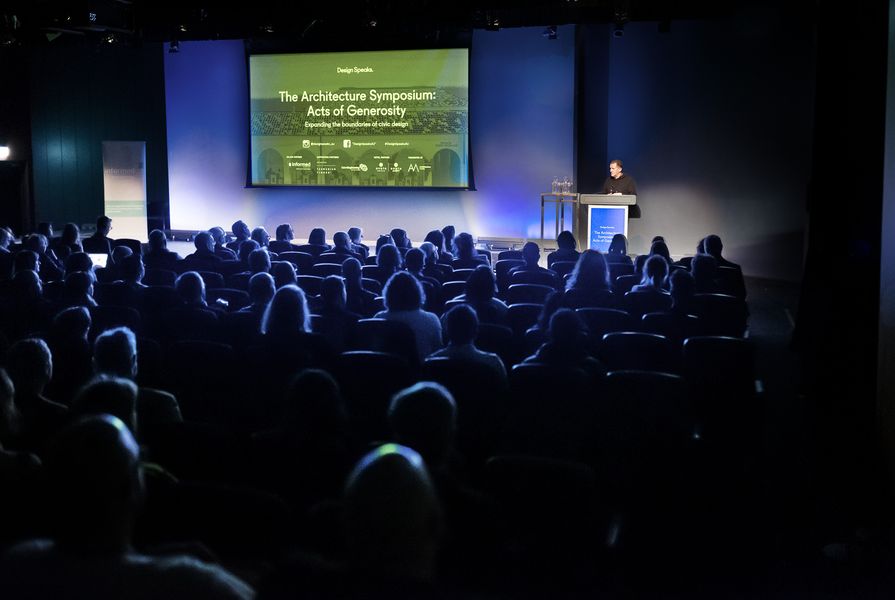Framed against the background of climate change, economic uncertainty and the housing crisis, The Architecture Symposium: Acts of Generosity, held in Melbourne on 8 September, explored the ways Australian architecture and landscape architecture is engaging with the idea of civic generosity. Curated by architects Amy Muir and Rachel Neeson as part of The Design Speaks symposium series, the program presented a set of diverse practices and projects that explored how designers are developing ways of working that support community and society, deliver public benefit and place people first.
Architecture typically frames the civic in terms of design typology – and this plays out in our public realm. Our state and federal parliaments, town halls and bureaucratic offices are all examples of civic buildings that are physical manifestations of governance and symbolic of the democratic aspirations of our society. Civic projects that are closer to the community include community centres, libraries, public parks and city squares. Although civic spaces and places are provided for the public and the community, they have not always been inviting. Over time, our understanding of the typology has changed. Today, greater emphasis is being placed on who these buildings are for, and a conscious effort is being made to deliver civic design that is more welcoming and inclusive.
Sibling director Nicholas Braun presenting The Architecture Symposium: Acts of Generosity.
Image: Blue Tree Studios
The projects presented as part of this symposium highlight the difference that civic generosity can make to the built environment. Public realm projects delivered by local council for local community are the most immediate path to civic generosity. The City of Melbourne’s urban civic projects, such as the Dodds Street project and the Queen Victoria Market redevelopment, stitch the city together, providing significant new infrastructure to address urban challenges and better connect residents and community to place. The City of Sydney’s George Street pedestrianization project redefines the city in terms of people, not vehicles, and will deliver three new public squares. Reflecting on this project, Bridget Smyth, city architect at the City of Sydney, said Sydney was “good at parties and New Year’s Eve but not at daily life.” For Smyth, the project highlights the fact that cities need big ideas to drive change and that these ideas need to be backed by grit and determination.
The Nambucca Heads Library extension by Vokes and Peters, and the new Drysdale Library – a collaborative effort by Architecture Associates and Antarctica – actively uncouple the civic from the idea of authority. Both projects carefully consider their threshold conditions, making warm and welcoming additions to their neighbourhoods. Alongside these larger civic projects are thoughtful, smaller-scale interventions such as Lymesmith’s Parramatta activations and the Mahon Pool Amenities by Lahznimmo Architects. These joyful expressions celebrate the everyday, delivering community amenity that outweighs the projects’ size and scale.
Projects such as the Melbourne Holocaust Museum by Kerstin Thompson Architects and the Inveresk precinct at the University of Tasmania by Wardle with Realm Studios and Aspect Studios exemplify the ways that new design interventions can amplify and pay homage to heritage and collective memory. By taking the old and weaving it through contemporary requirements, these designs ensure that our heritage not only remains relevant but is enhanced by its interaction with current use.
Rachel Neeson and Amy Muir introducing The Architecture Symposium: Acts of Generosity.
Image: Blue Tree Studios
Being civic implies a duty of care and a broader responsibility to the community or society. In this context, the civic can be identified not only in the form of architecture but also in its processes and ways of working. A civic sensibility is evident in the different ways designers are addressing sustainability and care. The Bendigo TAFE revitalization by Architectus with Six Degrees Architects and SBLA Studio considers sustainability in terms of caring for Country. A New Normal – a proposal for Greater Melbourne delivered in collaboration with Finding Infinity and a number of Melbourne architectural practices and aligned professionals – presents a utopian vision for a self-sufficient, sustainable and resilient city.
The civic mindset is also evident in projects that place community consultation at the heart of the design process. The result of a long community consultation process, Tonkin Zulaikha Greer’s Bondi Pavilion project retains the pavilion’s unique character while redefining it for the community and filling it with new life. Sibling Architecture’s Darebin Intercultural Centre reimagines the spaces within an imposing council building to address community concerns about its authoritative and uninviting presence. The project strips back the formal detailing to reveal the brickwork beneath, referencing Country through the earth from which the bricks were made, to create a more informal, colourful and welcoming space.
Perhaps the most significant rethinking of the civic is set against the broader social context of reconciliation, the Voice to Parliament and state-level commitments to treaty. The question of how architects can better design with, and on, Country underpinned many of the projects presented. Peter Stutchbury Architecture’s Wiradjuri Tourism Centre and BVN’s Yarrila Place clearly demonstrate the deep listening and careful consultation involved in this process. Kevin O’Brien described Yarrila Place – the outcome of a design process that prioritized First Nations’ agency throughout – as “making spaces that put people in a relationship with Country.”
Delegates at The Architecture Symposium: Acts of Generosity.
Image: Blue Tree Studios
While many projects celebrated Country, reconciliation and healing also require Australia to come to terms with its violent history. Architecture and landscape architecture need to not only consider First Peoples’ culture and knowledge but also engage with truth-telling. Nowhere was this more powerfully evoked than in the presentation by Rebecca Digney of the Aboriginal Land Council of Tasmania and Mat Hinds of Taylor and Hinds Architects, who looked at the site of Australia’s first mission. Established in 1833, Wybalenna was a site of exile, dispossession and brutal detention.It holds the bodies of more than 100 Aboriginal men, women and children. For Tasmania’s Aboriginal community, “Wybalenna is sacred and Wybalenna is a place for truth.” Currently, the Aboriginal Land Council of Tasmania is appealing for crowdfunding to undertake the work required to ensure that Wybalenna is conserved and adapted as a place of truth-telling and cultural interpretation.
In the closing panel, Ngunnawal woman and cultural advisor Kat Rodwell questioned the motivations of generosity. For Rodwell, what is important is giving back. This idea was most clearly articulated by Emma Williamson of The Fulcrum Agency, a practice that has built deep relationships with the Martu people and the Jamukurnu-Yapalikurnu Aboriginal Corporation (JYAC) in Western Australia’s Pilbara region. Building trust through small projects, The Fulcrum Agency worked with community to facilitate a community-led, co-designed masterplan to address housing and community infrastructure for JYAC. This masterplan places the needs of the community, and their cultural practices and protocols, front and centre in the design of future infrastructure, housing and community projects. Williamson clearly locates the act of generosity in community – not architecture – when she acknowledges, “The willingness of the community to participate in the process, when their experience to date has been systemic abandonment by the government, is the act of generosity in this exchange.”
Acts of Generosity was a timely and refreshing provocation, exploring the ways in which architects and design professionals are engaging with – and rethinking – civic form and civic responsibility. The idea and ideal of the civic is not set in stone; instead, its meaning is negotiated in a contemporary context in response to the needs of contemporary society. Annabel Lahz reminded us that “Architecture always has a public presence, and even a private house has a public address.” In the current challenging climate, it is inspiring to consider the ways that architects and designers are acting with civic generosity, giving back to their communities and working to build a better society.
The Architecture Symposium is a Design Speaks program organized by Architecture Media and supported by major partner Informed by Planned Cover, supporting partners Tasmanian Timber and Galvin Engineering, and hotel partner Ovolo South Yarra.






















